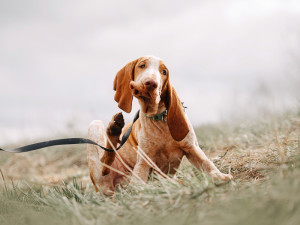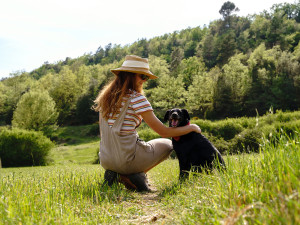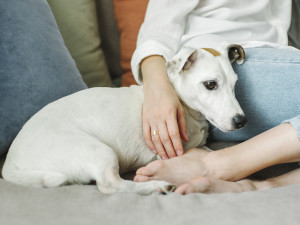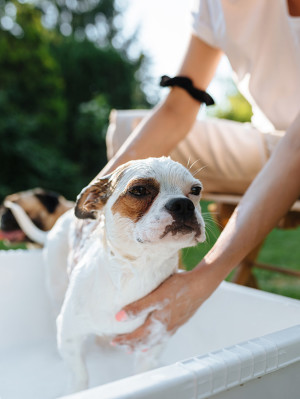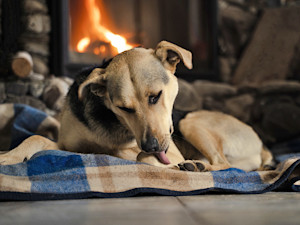Can You See Fleas on Dogs?
Come out, come out wherever you are, you little pests.
In This Article:
What Does A Flea Look Like On A Dog? Signs of Fleas On Dogs How to Check Dog For Fleas Differentiating Fleas From Other Issues Flea Prevention and Treatment Frequently Asked Questions
Fleas are the worst. Or at least one of the most annoying things that we deal with as pet parents. They drive our pets mad with itchiness, set up their extended families in our homes, and are a real nuisance to get rid of. And while you can see live fleas on your dog, other pets, or even in your home, usually the infestation has to be pretty bad for you to be seeing live fleas everywhere.
Early in an infestation, your dog will show signs of fleas long before you start seeing them. If you are seeing fleas, though, you can be pretty sure there are lots more you haven’t seen, and it’s time to get serious about your eradication strategy.
What does a flea look like on a dog?
Fleas are very tiny dark-colored insects that are usually black or brown in color and are the approximate size and shape of a sesame seed. They are fast-moving, can jump very high, and hang out directly on your dog’s skin where they feed. In order to see them, you often have to part the fur all the way down to the skin; that’s when you might notice little tiny bugs crawling around. Sometimes you may only see one, or none at all, but that does not reflect the total number of fleas that are actually present.
How much do you spend on your pet per year?
Signs of fleas on dogs
The primary sign of fleas is itchiness. Your dog will be extremely, relentlessly itchy and there will be no mistaking it. As a result of their discomfort, they may also act differently. Some of the other common signs you might see include:
Physical symptoms
Flea bites are very itchy. Your dog will try to soothe their itch in a variety of ways. They may start chewing at their skin, especially around the base of their tail and butt and they may also scratch frequently, using their hind legs to scratch at their sides, neck, or face. Some dogs may also develop skin changes as a result of the flea bites. They may have patches of redness, hair loss, or small scabs and bumps on their skin.
Behavioral changes
Being supremely itchy is no fun at all and as you might imagine, this affects your dog’s behavior too. They may be more irritable, agitated, and restless. This can affect their sleep patterns as they may be waking frequently to scratch. It may also affect their ability to enjoy their normal activities like going on walks, playing with toys, and snuggling if they are constantly stopping to scratch and bite at their skin.
Flea dirt
Flea dirt is also a telltale sign of fleas and is often visible even when you don’t see any live fleas. Flea dirt is actually flea poop, ew. It looks like black dandruff and can be found by parting the fur all the way to the skin, often around the base of the tail, along the back, or in the groin and belly areas. If you take some of the flea dirt and wet it slightly on a white napkin or paper towel, it turns dark red. This is because fleas dine on blood and their poop contains remnants of digested blood. While this may sound gross, this is an easy test to confirm that you have in fact found flea dirt, and therefore, fleas.
How to check dogs for fleas
There are a number of ways to check your pup over to look for evidence of fleas. This includes:
Visual inspection techniques
The simplest approach is to part the fur all the way down to your dog’s skin and look around in the spots where fleas like to hang out. This includes the base of the tail, the back, the belly, the groin area, and around the neck. You may see live fleas running through the fur, and you might find flea dirt too.
Flea combs
In cases where there are not a ton of fleas present or your dog has a very thick coat, a flea comb can help you do a larger survey of your pup’s fur. Flea combs are special combs with very fine metal teeth. This allows you to brush through your dog’s coat and trap loose fur along with fleas and flea dirt in the teeth of the comb. After you comb through sections of your dog’s fur, remove everything trapped in the comb, spread it out and examine it more closely for fleas or flea dirt.
The white paper test for flea dirt
If you do find material in the comb that looks sort of like black dandruff, you can confirm that it is flea dirt and not just regular dirt by placing it on a white napkin or paper and then getting it slightly damp. Flea dirt will turn red due to the digested blood, while regular dirt and debris will not.
Differentiating fleas from other issues
If you see live fleas or flea dirt on your dog, you can be sure that fleas are the culprit behind your poor itchy pup. But what if you don’t find convincing evidence of fleas and your dog is scratching non-stop? There are many other possible reasons for your dog to be itchy, and this is when you should definitely see your vet to get to the bottom of it. Some other considerations are:
Does my dog have fleas or allergies?
Dogs with allergies to food or something in the environment can also be very itchy. In these cases, they may show a lot of the same signs of itchiness, but with some unique features as well. For example, many dogs with allergies tend to also have itchy ears or recurrent ear infections. They also may have itchy butts and scoot around or have recurrent anal gland problems, too. Another way to differentiate fleas and allergies is that if you have multiple pets in the home and only one is suddenly itchy, this is less likely to be flea infestation. Fleas do not discriminate and readily jump from one pet to another, so in most cases of flea infestations, all the pets in the home will be acting itchy whereas allergies are unique to individual pets.
How to tell if your dog has fleas or mites
You will need a veterinarian to diagnose mites as they are microscopic and not visible to the naked eye. One of the most common skin mites, Demodex, is not usually itchy to dogs, so while you often see hair loss and scaly skin changes with this mite, you don’t see the same level of intense itchiness. Some other mites, such as Sarcoptes, do tend to be very itchy but they start out affecting the hairless parts of the dog such as the ear flaps, elbows, and belly, unlike fleas that prefer the base of the tail, back, and neck.
Fleas or dry skin
Dry skin can be itchy but it is not as itchy as fleas are most of the time. Dry skin is really a catch-all term for the way the skin looks, but the underlying causes can vary widely. Sometimes dry skin results from over-bathing and stripping the skin and fur of their natural oils. Other times, different underlying conditions are causing changes in the appearance of the skin or fur. As a result, the dry skin may be more localized to just one area of the body, or the fur may also be affected, which will look very different from the pattern we typically see with fleas. Your vet can help further characterize these conditions.
Compounding problems and flea allergy dermatitis
Sometimes, your dog can have fleas and another skin problem, or two, or three. This is where your vet’s expertise really becomes key. Fleas cause a lot of inflammation and damage to the skin and if your dog already has underlying skin problems, this can snowball into a more complex situation.
Some dogs are also highly allergic to flea saliva, known as flea allergy dermatitis. These dogs will have a more severe skin reaction from just a few flea bites. This can explain why some dogs are extremely itchy and uncomfortable even when you don’t find any live fleas. Other times, the fleas do a lot of damage to your dog’s skin and even after you kill the fleas, the skin is more vulnerable to secondary infections with bacteria or yeast.
This can help to explain why your dog’s skin may continue to be itchy and inflamed even after you get rid of the fleas. These are also important reasons to consult with your vet to help get to the bottom of your pup’s itchy skin. And, these are excellent reasons to keep your dog on preventative flea treatment year-round to prevent this cycle of fleas, inflamed skin, secondary infections, and more itching.
Flea prevention and treatment
Prevention is the ideal strategy when it comes to fleas, because once they get comfortable, they are difficult to get rid of. While many products kill adult fleas, the eggs and pupa life stages are extremely hardy and difficult to kill. This means that even after the adult fleas are killed, your dog could become re-infected as the next round of eggs hatch. Therefore, treating fleas is not just a one-and-done treatment, but rather an ongoing process that can take months. All of the animals in the home must be treated, all bedding and fabrics must be washed, and the home must be vacuumed frequently to try to remove as many flea eggs as possible.
When it comes to treating your pets, there are both oral and topical products that are very effective. You’ll want to make sure the products you use target as many life stages of the flea as possible and you’ll need to treat for at least three consecutive months, possibly longer in warmer climates, and then start year-round preventatives to prevent future infestations.
Even if you are able to get the flea infestation under control on your own, it is important to contact your vet. Fleas carry parasites like tapeworms, which can infect your dog as they are biting and chewing on their skin so they should be treated with an appropriate dewormer as well.
Be sure that the flea products you choose are safe for your pup and that you use the products exactly as the package recommends. For example, if the product is labeled only for dogs of a certain weight or age, stick to those guidelines. If you are using topical products, don’t bathe your dog for the recommended time frame in order to allow the products to work properly. And never use products meant for dogs on cats, or vice-versa, to avoid toxic reactions.
FAQs (People also ask):
Can humans get fleas from dogs?
Humans are not a permanent host for fleas. And while fleas cannot live on humans long-term, they can occasionally bite humans and transmit diseases through those bites. There are other conditions that humans and dogs can share, as well.
What should I do if my dog has fleas?
If your dog has fleas, it is very important to treat all the pets in the home as well as to do multiple thorough cleanings of the home to remove flea eggs from the environment, too.


